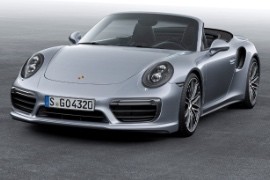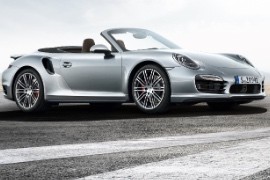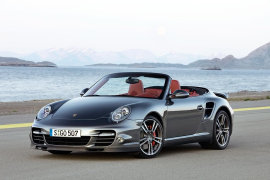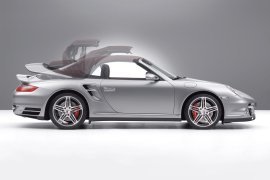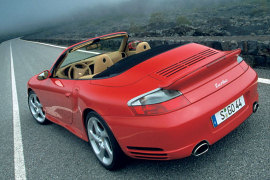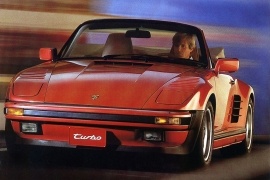PORSCHE 911 Turbo Cabriolet Models/Series Timeline, Specifications & Photos
First production year: 1987
Engines: Gasoline
Body style: Convertible (spider/spyder, cabrio/cabriolet, drop/open/soft top)
In 2016, the 991 generation of the Porsche 911 received a mid-life cycle refresh and it was introduced to the market. The Porsche Turbo Cabriolet was enhanced as well.
Ever since 1974, the introduction of a Porsche Turbo was a hot moment for Porsche enthusiasts. With the convertible versions, the famous supercar became more appealing for those who were looking for a daily-driver supercar and with the special appealing of an open-top. Moreover, since the 911 Turbo proved to be a great all-weather car, due to its all-wheel-drive system.
The facelifted version of the 991 was named 991.2. The car's front end was redesigned with side air blades and narrow LED lights, with double fillets to emphasize the car's width, as the additional fin in the main air intake. From the side, the new 20” light-alloy wheels were fitted as standard. The door handles without recess covers gave the car a sleeker look. The three-layer power-roof could have been opened or closed in 13 seconds at speeds up to 50 kph (31 mph).
Inside, the new Porsche Communication Management (PCM) with navigation system was fitted as standard. The system featured a 7” touch-screen on the center stack. Unlike its predecessors, the new PCM featured Google Maps with real-time traffic information and Google StreetView.
For the engine bay, the Porsche Turbo 991.2 Cabriolet offered 20 hp more than its non-facelifted version, reaching 540 hp. It was mated to a standard 7-speed automatic (dual-clutch) gearbox.
The 2013 Porsche 911 Turbo Cabriolet was unveiled 40 years after the introduction of the first Porsche 901 prototype at the 1963 Frankfurt Motorshow, along with its coupe-version.
As usual, every 911 generation starts with the Carrera models and the Turbo version comes later. It was always the same marketing strategy and it worked well for Porsche. The Turbo made its way up to the public in 2014, together with its convertible sibling.
In 1974, the first Turbo made it to the market, but it wasn't until 1988 when the first generation of the Turbo Cabriolet was unveiled. It was a great balance between sport and luxury. It started as a true, hard-core, sports-car, but it ended up as a better GT. In the front, the Turbo was distinguished by air scoops in black in the lateral grilles and a retractable spoiler. In the rear, the wide fenders were even larger than those found on the Carrera 4 version by 28 mm (1.1”).
Inside, the front sport seats with power 14-way adjustments were fitted as standard. They featured a memory package with electric steering column adjustments. The sport steering wheel was fitted with paddle shifters for the standard 7-speed automatic PDK (dual-clutch) gearbox. In the five-dials instrument cluster, the right one was a 4.6” high-resolution color display. The PCM (Porsche Communication Management) audio featured a twelve speaker Bose Surround System, including a 100 W active subwoofer. The power-operated soft-top needed just 20 seconds to open or cover the car, at speeds up to 50 kph (31 mph).
The drivetrain for the Turbo offered a 3.8-liter flat-six engine with direct fuel injection. It was aided by a pair of turbochargers with variable geometry. For better speed cornering, the car was fitted as standard with PASM (Porsche Active Suspension Management) and all-wheel steering.
The 2010 Porsche 911 Turbo Cabriolet was launched at the same time with the Coupe version at the 2009 Frankfurt Motor Show. And its performances were in the supercar territory.
The Cabriolet was built to offer the thrills and the look of a 911 Turbo version, but with a top that could be dropped for a pleasant, relaxed drive.
For the 2010 model, the car featured large air intakes and bar-shaped LED turn-signals. In the side-scoops air intakes needed to cool the front brakes, the designer incorporated the daytime running lights with LED, instead of the usual foglights. The headlights featured optional dynamic lights that improved illumination on the bends due to a swiveling mechanism. On the upper side of the rear fenders, a twin air-intake was placed to help to cool and feed the engine with fresh air. The wing on the engine hood made an important aesthetic difference between the Turbo and the rest of the 911 models.
The first Porsche 911 Turbo Cabriolet appeared in 1975 and offered a 260 hp from a flat-six 3.0-liter engine. Fast forward to 2009 and there still 6-cylinders flat under the rear hood and the engine grew to 3.8-liter displacement. Instead of one turbo, there are two turbochargers with Variable Turbine Geometry, a feature exclusive to Porsche. It was mated to either a six-speed manual or a 7-speed PDK (Dual-clutch automatic gearbox).
The 2007 Turbo Cabriolet Grand-Tourer by excellence and offered unrivaled performance for a convertible. While it wasn't a track-focused vehicle, it could offer thrills under the open sky.
In February 2006, Porsche unveiled the Turbo Cabriolet at the Geneva Motor Show. It looked more aggressive than its Carrera siblings. The air-intakes on the rear fenders told the world that the 911 was back and promised to offer exhilarating performance on the street and to be a fierce competitor on a track for a weekend race.
On the front, a new bumper with LEDs incorporated into the outer air inlets was designed. The center grille was as wide as it could, without interfering with the side scoops needed to cool the brakes. A new set of sills was installed and, on the wide rear wheel-arches, the split air-intake made a good impression. At the back, an extendible split-wing was installed. The convertible was developed at the same time with the coupe version, and that led to better integration of the supplementary reinforcements needed for an open-top vehicle. It was able to cover and uncover in 20 seconds, at speeds of up to 50 kph (31 mph).
Inside, the 911 Turbo was a mix between a GT and a super-sport vehicle. Its interior was leather upholstered as standard. The sport-bucket seats were powered and with memory for the driver's side. Like its predecessor, the 2006 Turbo came equipped with the PCM (Porsche Communication Management) system, including the DVD-based navigation system.
The 3.6-liter engine was turbocharged with a Variable Turbine Geometry, which was a first on the market for a gasoline engine. That, along with a bigger intercooler, allowed a faster response from the engine. With its 480 hp and the all-wheel-drive system, the car could sprint from standing still without wheelspin.
It was the first Porsche Turbo Cabriolet since the 964 generation (in 1989) and confirmed the GT intentions for the Turbo version. It was built for the pleasure of open-top driving experience than for speed.
When it was introduced, it suddenly made its competition look outdated. Its all-wheel-drive system and the mix of performance and comfort it added, made it one of the best choices on the market, and new buyers didn't care too much about the fact that it didn't feature an air-cooled engine. It was faster than most of its competitors, and it was almost as comfortable as a British GT car.
From the outside, the front bumper attracted views due to its large three air-intakes needed to cool the radiators. On its sides, another pair of air-intakes needed to feed the big turbochargers were installed in front of the rear wheels. The wide rear fenders looked muscular. With the retractable roof folded down behind the cabin, a hump was needed to aerodynamically enhance the profile.
Only 20 seconds were needed to cover or uncover the top. The car was tested in the wind tunnel at speeds of up to 338 kph (210 mph) without problems. The three-layer folding roof ensured better insulation. For the interior, leather seats and Porsche Communication Management with sat-nav were available at extra costs.
The 996 Turbo was fitted with an engine carried-over from the Porsche GT3 race-car and detuned for street use. It was mated as standard with an all-wheel-drive system, and that led to a smaller luggage compartment and smaller fuel tank. A 5-speed automatic gearbox (Tiptronic) with manual override to change gears and paddle shifters were offered as an option.
Starting with 1987, Porsche offered a reworked front end for the Turbo Cabriolet model, inspired by the famous 935 race-car. It was the open-top version of the 911 Turbo Flachtbau Coupe.
After 1981, when Porsche introduced the 911 Turbo Flatnose (Flachtbau) for the coupe version, customers started to ask if the brand can do the same for the convertible version. At first, the German car-manufacturer didn't want to do that. Later on, the agreed and offered it as the option 505 for the U.S. market or 506 for the rest of the world. It was an expensive one since it meant that the manufacturing process was to take a completed vehicle, dismantle, and mount the new elements. In 1987, that cost was USD 23,244 (USD 53.000 in 2020's money).
The car featured a flat, aerodynamic, front end, with the fenders flushed to the trunk lid. On top of the wheel-arches, there were air exhausts for the wheel-wells. All units were modified by Porsche by dismantling and reassembling already built vehicles right after they came out of the production line. That contributed to the car's aerodynamic and led to better performances on the road. At higher speeds, the front end was better planted to the road due to higher downforce.
The 1987 model was better equipped than its predecessor. It featured air-conditioning, power-windows, and heated seats on the options list. The instrument cluster was the same as in the Carrera and there was no turbo-gauge.
For the U.S. market, where 591 models were built, the 911 Turbo offered a reworked engine to comply with the emissions regulations. But that meant that the power was reduced to a mere 282 hp from its initial 330 hp. It was mated to a standard 4-speed manual and there was an option for a limited-slip differential.
PORSCHE 911 Turbo Cabriolet "Flachtbau" (930) 3.3L 4MT (330 HP)
